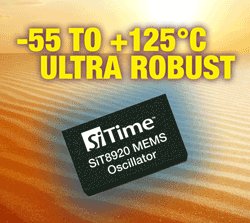The SiT5003 is the most flexible LVCMOS/LVTTL/HCMOS compatible, ultra-stable MEMS VCTCXO (Voltage Controlled, Temperature Compensated Oscillator) solution in the market. This device supports any combination of the following features: frequency (1 – 80MHz), voltage (1.8V, 2.5V-3.3V), stability (±0.5PPM), pull range (±12.5PPM to ±50PPM) and 4-pin packages (3225, 5032, 7050). It provides superior shock and vibration resistance, and 2 FIT reliability that is 10 times better than crystal VCTCXO and TCXO oscillators and is ideal for high reliability applications in telecom, networking, wireless and embedded. SiTime’s MEMS devices are 100% compatible with legacy quartz crystal VCTCXO and TCXO oscillators in footprint and package, and replace these devices without any design changes.
Features
- Excellent frequency stability of ±0.5 PPM over industrial temperature range (-40 to +85°C)
- Excellent timing margin for high reliablity systems like GPS
- Extensive programmability
- Any frequency from 1MHz to 80MHz with 6 decimal places of accuracy and without any coverage gaps that are always present in crystal VCTCXO and TCXO oscillators
- Supply voltage of 1.8V, 2.5V to 3.3V (continuous)
- Voltage control option, pull range from ±12.5 PPM to ±50 PPM
- Configurable drive strength
- Customized specification for optimal system performance
- Easy availability of any device specification within the operating range
Improve system robustenss in all operating environments
Reduce field failures due to clock components and the repair cost
A US team has created a silicon frequency reference with frequency stability better than +/-0.5ppm from -40 to 85°C, along with Allan deviation (long term jitter) better than 0.005ppm for 0.1, 1, and 10s strides.
It is a two chip solution: a MEMS chip on top of CMOS circuitry, with a thermistor on the MEMS used to cut errors “since the MEMS resonator has a well-defined temperature dependence”, said the researchers.
From a raw temperature coefficient around -31ppm/K, 5th-order polynomial correction is applied digitally to get the final stability.
The design uses a complex chopper-based temperature to digital converter that suppresses electromigration-induced drift by keeping DC current through the thermistor close to zero.
Set to 48MHz output with no load, current consumption is 33mA from 3.3V.
Measured current consumption for all analogue and digital circuits in the temperature to digital converter and clock multiplier is 3.93mA.
The development team were at SiTime in Sunnyvale, and the temperature to digital converter was reported in detail at ISSCC 2012 in San Francisco.
“The work has resulted in a product for SiTime, the SiT5003“, Piyush Sevalia, v-p of marketing at the firm, told Electronics Weekly.
For more read: temperature compensation delivers from MEMS oscillator

